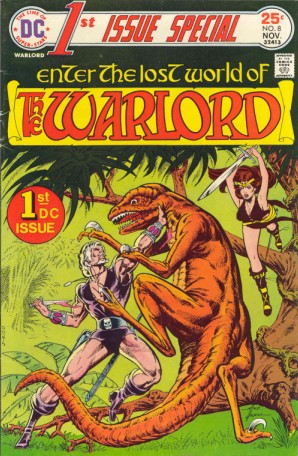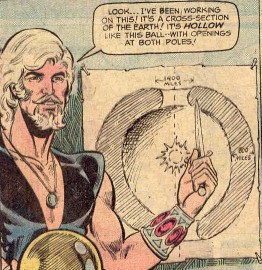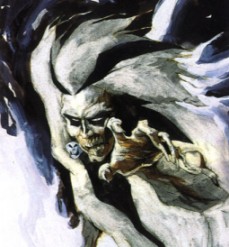| Derek's
Continuity Corner:
"Chaos at the Earth's Core"
Enter the lost world of the Warlord…
So touted the cover of First Issue Special
#8, DC's showcase book of the 70s, not to be confused
with Showcase. Twelve issues went by of various creators
taking shots at new concepts or reviving old ones (Metamorpho
got a solo shot by his original creative team, thus cementing
a lifetime of one man's fandom and another man's mockery).
With lucky number thirteen, the title morphed into a very
short Return of the New Gods, but only Warlord
became anything like a success.
Some of us long for the second appearance
of the Green Team (First Issue Special #2), which
actually was commissioned by DC. Some of us really need
help.
Chased
by Soviet missiles over the North Pole in 1969, Air Force
pilot Travis Morgan crashed his jet above what he thought
was the Yukon. He parachuted over a landmass he spotted
in a break through the clouds.
It actually
served as the doorway to a strange land near the Earth's
core. Likely, Skartaris is actually extra-dimensional, but
creator Mike Grell served a tradition older than comics
with his Warlord. His underground world bears more than
a passing resemblance to Edgar Rice Burroughs' Pellucidar.
A strange
world where dinosaurs, cavemen and something in between
all walk together, Skartaris turned out to be a good fit
for Morgan, a pilot searching for new frontiers to conquer,
which ultimately led him to rule the nation of Shamballa.
The
series ran well into the eighties, much of it still under
the guidance of Grell. At one point, it even spawned a toy
line from Remco, with body types similar to what Mattel
used for He-Man.
Morgan
occasionally crossed swords with the mainstream DCU, often
in situations where he was confused for Green Arrow. Grell
wrote and drew both series, with the main physical difference
between the two being hair color.
Admittedly,
though, Warlord was not a book that really caught
my attention. Not exactly quasi-medieval, it's straightforward
Sword & Sorcery, a genre I came to appreciate much later
in life. So if anyone else has something to say on the subject,
be my guest.
As
for Silver Banshee, she started out as a foe of Superman.
Siobhan McDougal was an Irishwoman suffering an ancestral
curse. Killed and allowed to return to Earth as the Silver
Banshee, she fought Superman and was eventually destroyed.
One of the longest lasting and visually arresting additions
to the mythos by John Byrne, the Banshee also stands as
one of the few villains who can legitimately hurt Superman
- her powers are magic-based.
If
you hear her scream, you die. For reasons that escape me
now, Superman's physiology can survive it. Initially, the
Banshee was motivated by revenge, but a second Banshee appeared
after McDougal's destruction that had more of a generalized
stir some crap up attitude. Really, with a look like that,
she had no choice but to eventually turn to a straightforward
life of crime.
Has
she faced the Black Canary? Actually, I'm not sure, but
it does seem a pretty logical match-up. Maybe Gail Simone
will tell us.
Then there's Metallo, the man with the
Kryptonite Heart. The animated version retains some human
appearance, as the character did in the Silver Age. In the
comics, he's a hodge-podge of metal with the ability to
leap from mechanical device to mechanical device. His kryptonite
heart certainly makes things difficult for Superman.
Both comics and television give him the
real name of John Corben, but the animated series has made
him a little more refined. Voiced by Malcolm McDowell, Metallo
has a twinge of the urbane to him, but in comics, Byrne
revised him as a low-class thug that fell victim to an unfortunate
experiment after a car crash.
Metallo also made an appearance on Lois
& Clark, one of the few Superman villains to make that
leap. There he was somewhere in between, played by Scott
Valentine, Mallory's boyrfriend Nick on Family Ties.
Perhaps the less said the better.
|








